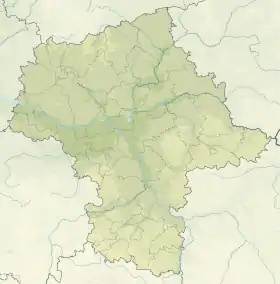Grębków (gmina)
La gmina Grębków est un district administratif (gmina) situé en milieu rural, dans le powiat de Węgrów, en voïvodie de Mazovie, dans le centre-est de la Pologne.
Pour les articles homonymes, voir Grębków.
| Gmina Grębków | ||||
 Héraldique |
||||
| Administration | ||||
|---|---|---|---|---|
| Pays | ||||
| Voïvodie (Région) |
Mazovie | |||
| Powiat (District) |
Węgrów | |||
| Siège | Grębków | |||
| Plaque d'immatriculation | WWE | |||
| Démographie | ||||
| Population | 4 629 hab. (2006) | |||
| Densité | 35 hab./km2 | |||
| Géographie | ||||
| Coordonnées | 52° 31′ 54″ nord, 21° 42′ 38″ est | |||
| Superficie | 13 075 ha = 130,75 km2 | |||
| Localisation | ||||
| Géolocalisation sur la carte : Voïvodie de Mazovie
Géolocalisation sur la carte : Voïvodie de Mazovie
Géolocalisation sur la carte : Pologne
| ||||
| Liens | ||||
| Site web | www.grebkow.pl/ | |||
Son siège administratif (chef-lieu) est le village de Grębków, qui est situé à 16 kilomètres de sa capitale, et à 61 km de Varsovie (capitale de la Pologne).
Elle a une superficie de 130,75 km2 et une population de 4 629 habitants en 2006[1].
Géographie
La Gmina Grębków comprend les villages de :
_location_map.png.webp)
Plan de la gmina
- Aleksandrówka
- Chojeczno-Cesarze
- Chojeczno-Sybilaki
- Gałki
- Grębków
- Grodzisk
- Jabłonna
- Kolonia Sinołęka
- Kopcie
- Kózki
- Leśnogóra
- Nowa Sucha
- Nowa Trzcianka
- Ogródek
- Oszczerze
- Pobratymy
- Podsusze
- Polków-Daćbogi
- Polków-Sagały
- Proszew A
- Proszew B
- Słuchocin
- Stara Sucha
- Stara Trzcianka
- Stawiska
- Suchodół
- Trzebucza
- Żarnówka
- Ziomaki
Démographie
Données du :
| Description | Total | Femmes | Hommes | |||
|---|---|---|---|---|---|---|
| Unité | Nombre | % | Nombre | % | Nombre | % |
| Population | 4 650 | 100 | 2 292 | 49,3 | 2 358 | 50,7 |
| Densité (hab./km²) | 35,6 | 17,5 | 18 | |||
Annexes
Liens internes
Liens externes
Références
- (en) « Area and Population in the Territorial Profile in 2012 », Głowny Urząd Statystyczny
Cet article est issu de Wikipedia. Le texte est sous licence Creative Commons - Attribution - Partage dans les Mêmes. Des conditions supplémentaires peuvent s'appliquer aux fichiers multimédias.


